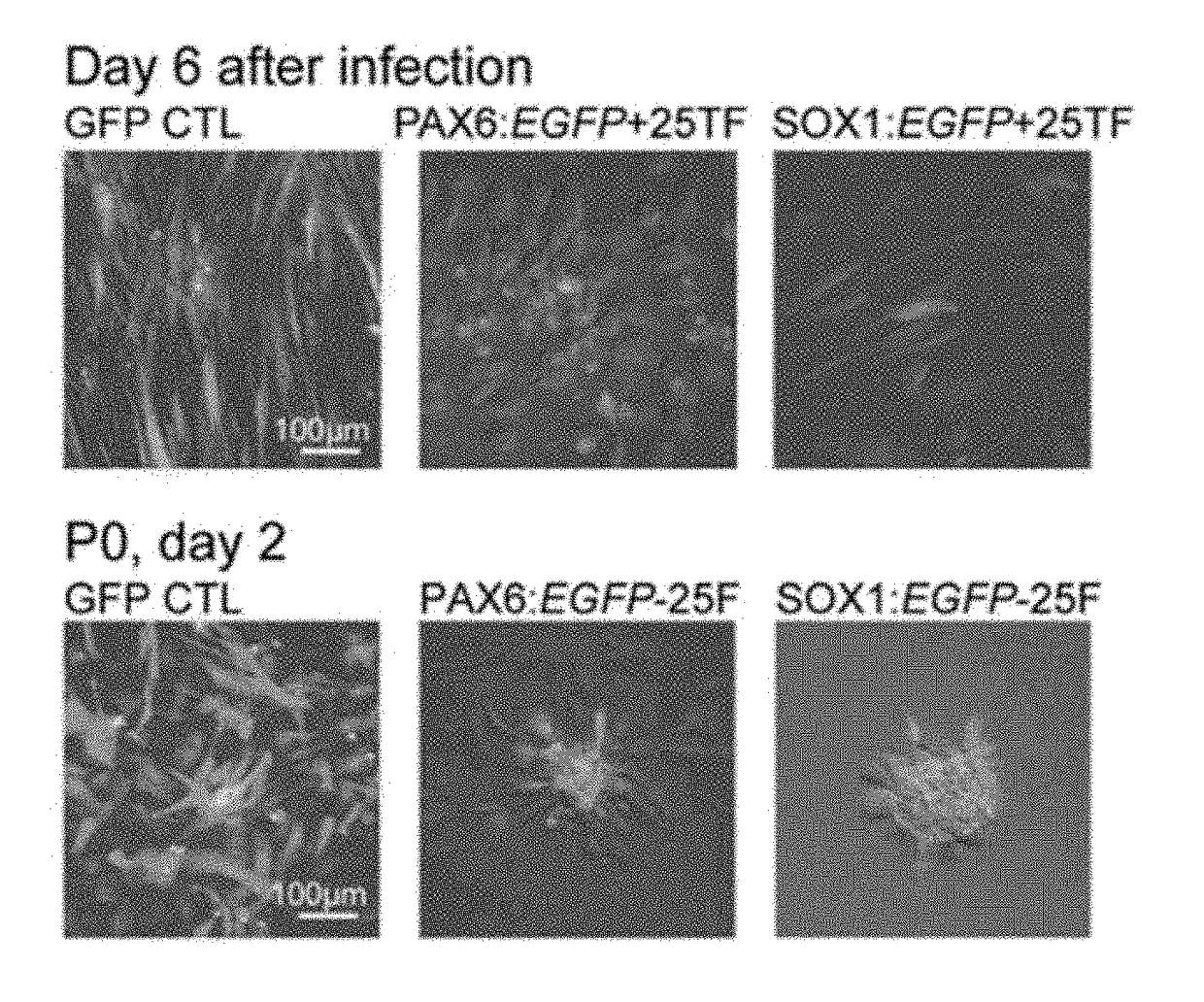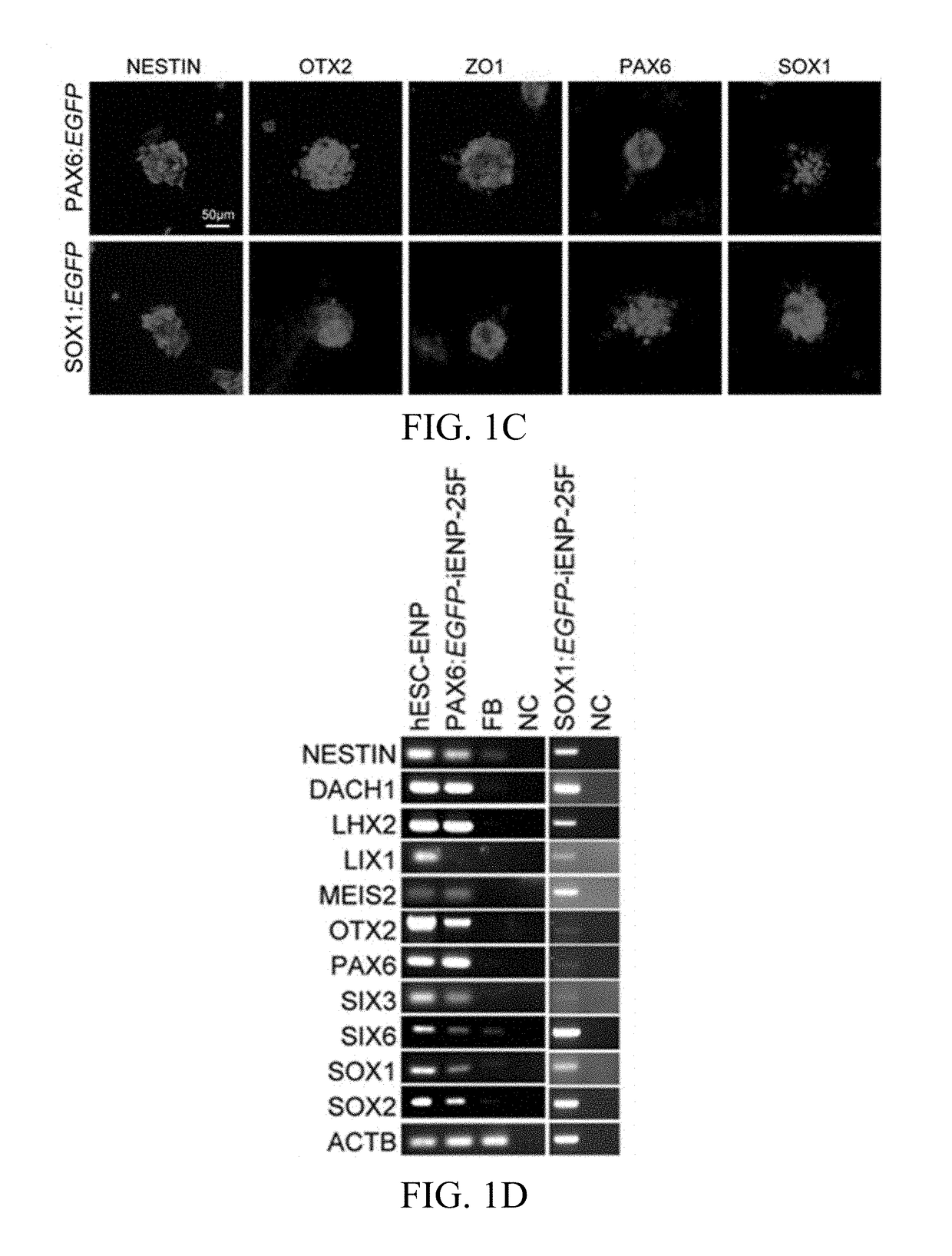Kit for selecting neurological drug and uses thereof
a neurological drug and drug selection technology, applied in the field of neurological diseases, can solve the problem of low yield of such ins for meaningful clinical applications
- Summary
- Abstract
- Description
- Claims
- Application Information
AI Technical Summary
Benefits of technology
Problems solved by technology
Method used
Image
Examples
example 1 conversion
of iENPs from Human FBs
[0105]1.1 Selection of Transcription Factors
[0106]To screen potential TFs for iENP generation, we compared the global gene expression profiling of multiple hESC-ENP and FB populations by microarray analysis (FIG. 1A, Panel a). Twenty-four TFs were selected based on their greater levels of expression in hESC-ENPs than in FBs (FIG. 1, Panel b). NR2F2 was also selected because it was previously reported to be crucial for neural differentiation. As the hESC-ENP-TFs were highly expressed in heterogeneous ENP populations derived from hESCs, there is a possibility that certain combinations of our 25 hESC-ENP-TFs may be able to induce different types of ENPs from FBs. To this end, two reporter systems, PAX6:EGFP and SOX1:EGFP, were created to monitor the progression of neural fate conversion and to evaluate ENP induction efficiency, as both PAX6 and SOX1 have been reported to be expressed in hESC-ENPs. We confirmed that these reporters are expressed in hESC-ENPs (FIGS...
example 2
Multipotency of iENP In Vitro
[0112]As functional ENPs can differentiate into astrocytes, oligodendrocytes, and neurons, we examined the ability of our iENPs to differentiate in vitro (FIGS. 3 and 5). After 2-3 weeks of differentiation, GFAP+ and GALC+ cells and abundant neuron-like cells exhibiting neuronal process and expressing neuronal marker MAP2, NEUN, or TUJ1 were readily observed in both differentiating iENP-6F (FIGS. 3A-3D) and -7F cells (FIGS. 5A-5C) under neural differentiation conditions. Notably, the synapse marker synaptophysin (SYP) was also found co-expressed with mature neuronal marker, NFH (FIG. 3E). Further, quantification of the proportion of cell expressing TUJ1 GFAP, and GALC in the differentiating iENPs by ICC analysis revealed that the neuronal differentiation ability of iENP-6F was similar to that of hESC-ENPs, whereas iENP-15F was less able to generate neurons as compared to hESC-ENPs and iENP-6F, suggesting that removal of the 9 TFs from the 15-TF combinati...
example 3
Transplanted iENPs Integrate and Differentiate in Rat Brains
[0115]To assess the in vivo differentiation potency of iENP, we transplanted the iENPs into the corpus callosum of rat brains, and analyzed the brains 12 weeks after transplantation (FIGS. 3P and 5M). We first examined whether iENP transplantation caused tumor formation in the brain. H&E staining of brain sections and further RT-PCR and IHC analyses revealed no expression of tumor-associated markers or tumor formation in iENP-transplanted brains at 12 weeks post transplantation (FIG. 9). Interestingly, we found some of the transplanted cells migrated to the ventricular zones, a brain region where neurogenesis takes place, and GFAP, a radial glia progenitor marker, is expressed (FIG. 3P, Panels a-b; and FIG. 5M, Panels a -b). Consistent with the in vitro differentiation results, the transplanted iENPs were found to have differentiated into GFAP+ astrocytes (FIG. 3P, Panel c; and FIG. 5M, Panel c), NG2+ oligodendrocytes (FIG....
PUM
 Login to View More
Login to View More Abstract
Description
Claims
Application Information
 Login to View More
Login to View More - R&D
- Intellectual Property
- Life Sciences
- Materials
- Tech Scout
- Unparalleled Data Quality
- Higher Quality Content
- 60% Fewer Hallucinations
Browse by: Latest US Patents, China's latest patents, Technical Efficacy Thesaurus, Application Domain, Technology Topic, Popular Technical Reports.
© 2025 PatSnap. All rights reserved.Legal|Privacy policy|Modern Slavery Act Transparency Statement|Sitemap|About US| Contact US: help@patsnap.com



